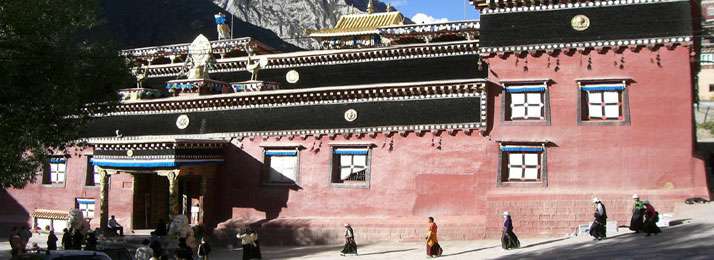
Dege Sutra-Printing House (Tib. Dege Parkhang), also called Dege Auspicious and Wisdom-Gathering House, whose full Multi-Auspicious Gate of the Great Dharma Stack-Room of Dege Sutra-Printing House of Tibetan Cultural Treasures, is located in Gengchen Temple in Dege County on the east bank of the Yangtze River northwest of the Ganze Tibetan Nationality Autonomous Prefecture of Sichuan Province, built in the 7th year of Emperor Yongzheng of the Qing Dynasty by Chokyi Tenpa Tsering (1687-1738), the 12th headman and 6th dharma-raja of Dege. In the house are kept more than 200000 blocks of religious, historical, literature and art, medical, astronomical and calender-arithmetical book editions in Tibetan, of which the Dege block edition of The Great Scriptures cut in the Qing Dynasty is expectably well-known. The Printing house is the largest of the three big Sutra-printing houses in the Tibetan regions of China (Lhasa Sutra-printing House in Tibet, Lhapuleng House in Gansu and Dege Parkhang in Sichuan). It was designated as a major unit of cultural relics under provincial protection in 1980 and as a major unit under state protection in 1996.
The Dege Parkhang is situated in Tibetan Autonomous Prefecture of Garze in Sichuan Province, Dege County, although endowed with an appealing landscape, is secluded from the outside by snow-capped mountains. Its seclusion, however, to a large extent contributes to the survival of traditional culture. Dege Scripture Printing House, credited as ‘the encyclopedia of Tibetan culture,’ is among the well-protected in the region.
Dege Scripture Printing House is the largest traditional press in the Tibetan area of China, and it stores an estimated 70 per cent of Tibetan literary heritage. The subjects of its collection fall into a dozen categories, including Buddhist classics, medicine, mathematics, and literature. The construction of the press began in 1729, but the woodblock printing practice actually appeared in the region in 1703 with the financial support of local government officials.
The press has never stopped operation except for a 20-year period from 1958 to 1979, when all kinds of traditional culture were suppressed in China. In 1979, the Dege Scripture Printing House was allowed to resume operations, and in recent years it has flourished.
Special woodblocks and paper are made for printing Buddhist scriptures. No mechanization, they are all hand-made even today. The woodblock material is red birch, which is ideal for engraving and can remain in good condition after hundreds of years of erosion. A desirable woodblock is not completed without being smoked, boiled, sunned, and polished. Text carved deep in the woodblocks is done in wonderful calligraphy, and is suitable for repetitious printing because of special carving skills used. Paper for printing is made from a kind of Daphne plant root, and undergoes several processing stages like washing, steaming, airing, and polishing before use, making them strong, durable, ink-absorbent, and able to resist damage from bugs.
High costs and demanding processing techniques are needed to produce woodblock prints in Dege. Therefore, more effort is necessary to protect the art of printing from dying out.
Dege, meaning “land of benevolence” in Tibetan, is derived from the “ten benevolences of the 4 orders” of Tibetan Buddhism. The Dege clan and the toponym of Dege both began to appear in the early period of the Yuan Dynasty and the year of 1913 saw the establishment of Dege County. It is the seat of Dege County, and was once the center of the kingdom of Dege, one of the largest and most important of the regional kingdoms in Kham.
For more information of this place or want to travel to this area, please contact us at [email protected] and our local expert will reply you with details.
Locals working at the Dege Printing House and printing the Buddhist scriptures in their traditional way.
Tibetans Printing Buddha Images by the traditional Woodblocks
Printed Buddhist Images by the Dege Printing House by using the traditional printing woodblocks.
